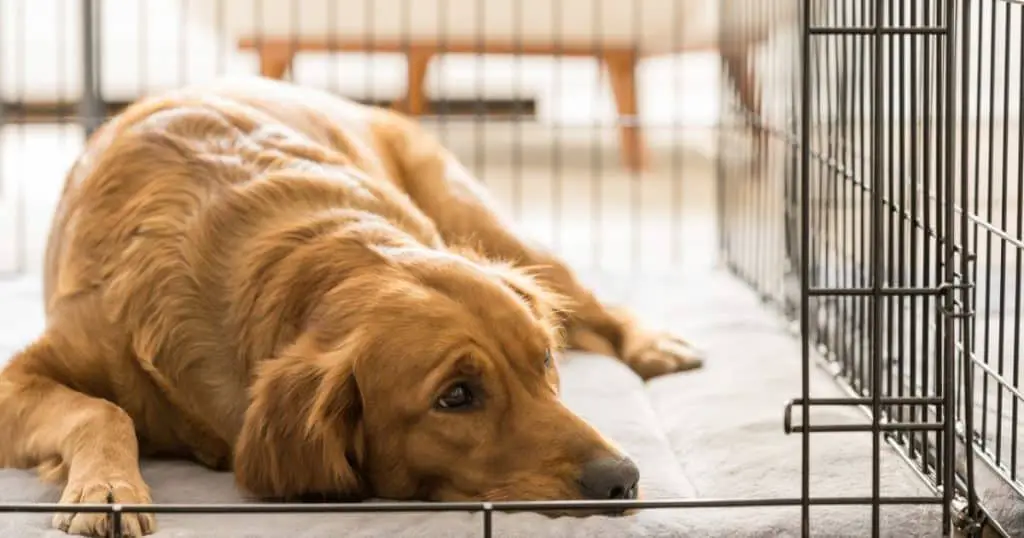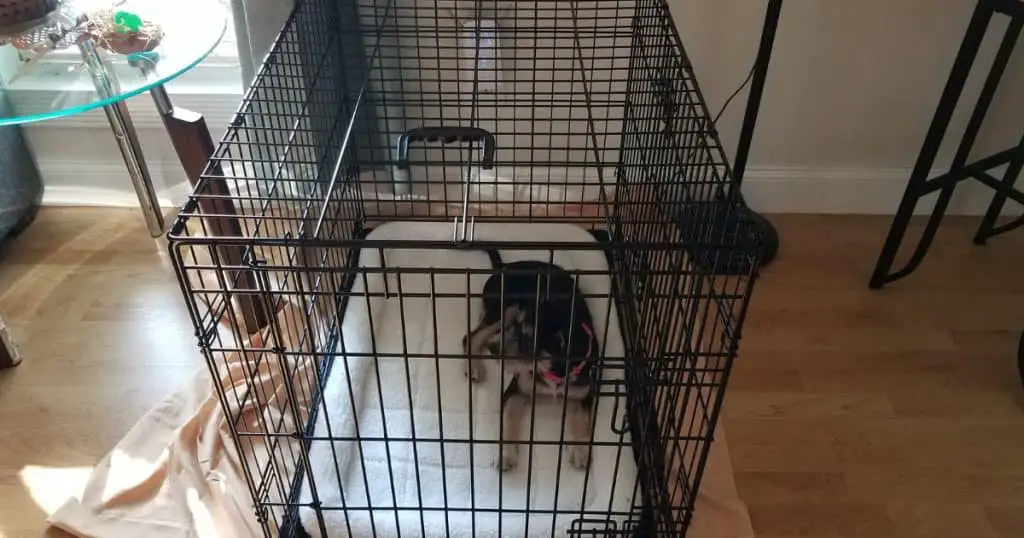What to Know
Are you wondering if you should invest in a bulldog crate or not? Are you confused between various options in the market?
Are you planning ways to train your Bulldog for it?
You do not need to worry now. Allow me to provide a detailed guide on the subject of bulldog crate in this article.
Coming from the wild, canines have a dedicated habitat to themselves. Living in closed caves or dens has been the staple. A quarter opening with other sides sealed has been the living space for tigers, lions, and other canines.
Over time and domestication of dogs, they indeed have come to live like us. But, no matter how much you take your dog to play out in the sun or the ground, they will retreat to their cozy corners.
Having a separate corner for your Bulldog will provide him or her a feeling of safety, security, and comfort. A dog crate is what used to be the dens for canines’ ancestors.
For obvious reasons, we cannot give them the wilderness environment at home. However, providing a dog crate to your pooch will give similar coziness and comfort to your Bulldog.
What is a Dog Crate?
A dog crate is typically a plastic (sometimes named flight kennels or Vari-Kennels) or adjustable metal-enclosed cage that is only wide enough for a dog to stand up and turn about.
The crate is the spot for the dog to be in when no one is around to monitor him.
It is the bed and shelter of a dog. It aims to provide confinement for protection, dog safety, household training, disruptive conduct prevention, and transit.
Why use a Dog Crate?
Housetraining is the primary use of an crate since your pups do not want to stain their dens.
Although they learn other rules, such as not chewing on furniture, the crate will restrict their access to the home’s interior.
Crates are a convenient way to hold your Bulldog in the car as well.
Crating a Bulldog puppy shows him which toys to chew on and what we may not want them to chew.
Using a crate is the secret to developing healthy habits and avoiding negative patterns that can be difficult to break.
For dogs, separation anxiety is a significant concern. Proper use of the crate will help decrease the risk of anxiety issues formed by your Bulldog.
It becomes a spot where your dog feels secure and out of danger, even when alone.
The Bulldog puppy can’t get into any trouble when puppy crate training is done correctly. By training your pup, you eliminate the need to punish it.
The crate is a safe place (for your dog breed) to live in but not for long periods.
Your pup is protected from a range of potentially hazardous household items in its crate. Annually, many puppies are killed or seriously injured due to chewing wires, ingesting toxins, or swallowing foreign objects.
Choose the Perfect Dog Crate
While Dog crate sizes can differ depending on your dog’s dimensions and age, it is usually suggested that adult bulldogs use crates that are forty-two inches long and are thirty to thirty-six inches in width.
Bear in mind that those figures are suggestions that are the standard. Your dog might need a smaller dog crate (significantly if they’re still growing) or a larger one.
It would help if you determined your Bulldog’s width and height before you buy something (and then add three or four inches to the readings).
These final numbers will give you a preliminary idea of the scale of the crate.
Factors to Consider While Buying a Dog Crate

Sizing is the crucial aspect to note when purchasing a dog crate for your dog. Different items are available in multiple sizes, but they can also use their sizing references. If your Bulldog is still young, searching for crates with divider panels is one option you can consider to save a little cash.
Makers typically sell various ranges of dog crates:
- Around 24 inches tall, an extra-small dog crate is designed for dogs up to 25 pounds.
- The length of a small kennel or crate is about 30 inches and is built for bulldogs weighing 26 to 40 pounds.
- The medium crates are about 36 inches and are designed for dogs weighing 41 to 70 pounds.
- Big crates measure about 42 inches and are 71 to 90 pounds in weight for dogs.
- Extra-large crates are 48 inches in height and are meant for dogs weighing 91 to 110 pounds.
- It can be around 54 inches for a giant crate; it is for use with bulldogs weighing over 110 pounds.
Divider panels allow you to divide various areas of the box before you’re ready to use them. That way, your Bulldog wants to use the room he wants, so you won’t need to buy a larger dog crate later on.
Another challenge is hygiene. You shouldn’t be shocked if your dog is still home-trained if they end up creating a few accidents in the dog crate, most particularly if they’re left alone for a few hours. Fortunately, many wire cages have disposable trays so that the whole crate does not need to be washed down.
Types of Dog Crates in the Market

All the different options can feel daunting when you’re shopping for a dog crate. Not only are there various varieties of crates eligible, but every kind offers additional facilities.
- For the knowledge of crates, recognizing a wire cage is crucial. These folding crates look a lot like cages. Because they provide plenty of ventilation, they’re also a popular option among bulldog owners.
- Wire cages use thin wire barriers that won’t impact your dog’s ventilation, unlike individual wooden crates or plastic crates. The wire cage allows your Bulldog an abundance of ventilation. The only drawback to a wire cage is that it can also make your dog feel overexposed
- A plastic kennel could be the better choice if a wire cage causes your Bulldog to feel nervous and overexposed. Typically, plastic kennels have a sturdy shell and handle so that holders can pick up the crate from spot ‘A’ to point ‘B’ and move it. Plastic kennels are also referred to as “travel crates,” but as indoor containers, they are also useful.
- Another tool at your disposal is soft kennels. To envelop your Bulldog, Soft kennels use a cloth that’s kept up with steel tubing rather than metal wire or plastic. As a result, it might be a little more secure and convenient to carry your dog crate, but it might not be as reliable and sturdy as a wire cage might be.
- For indoor uses, a wooden dog crate could be an ideal option. Wooden crates use wood that looks sleeker instead of contrasting with the decor of your house. While it’s not always easy to move wooden crates, they can be one of the most robust kennels out there.
Recommendations for Buying the Appropriate Dog Crate

There are plenty of average options out there, but there should be no reason for your dog to settle for boring. The best crates are:
#3 MidWest Life-Stages Double Door Dog Crate
Figuring out where to store it may be one of the trickier aspects of purchasing a bulldog crate. For example, plastic kennels can be cumbersome and hard to fit around your home.
Luckily, with the MidWest LifeStages Double Door Dog Crate, storage is not a concern.
We earn a commission if you click this link and make a purchase at no additional cost to you.
Not only can you fold it up when you’re finished with it, but the design also includes handles so that you can move it from one position to another.
You may be pleased to find out that this crate also has a splitter panel if your Bulldog is still growing up.
Till your Bulldog is large enough to be using them, you can section off portions of the crate.
#2 2PET Folding Soft Dog Crate
We earn a commission if you click this link and make a purchase at no additional cost to you.
While it may be easy to store and set up wire cages at home, they are not always the easiest to carry about.
The 2PET Folding Soft Dog Crate might be an excellent option if you intend to take your dog everywhere.
Although lightweight, the soft kennel uses heavy-duty polyester material that can withstand stains and water damage. It is doubtful that even violent chewers can shred or tear this fabric.
You will be pleased to find out that there is a screen mesh door to ensure that your puppy gets all the ventilation they need because bulldogs needed an abundance of airflow.
#3 Amazon Basics Foldable Metal Dog
The Amazon Basics Foldable Metal Dog is suitable for both puppies and adult dogs and provides outstanding comfort. The Amazon Basics Foldable dog crate can be used for many purposes, from everything from potty training or house training to establishing house rules and boundaries, or only as a comfortable, safe spot for your pup to ease up.
We earn a commission if you click this link and make a purchase at no additional cost to you.
The AmazonBasics metal dog crate includes a single swing-open front door. The wide opening allows you to clean the mess by your pet. The door’s two slide-bolt latches help guarantee a stable and protected enclosure.
In almost no time, the Amazon Basics metal dog crate sets up quickly — no machines are needed. Start laying the folded crate flat, then unfold and lift the sides and top of one piece to build the initial structure.
Then, swing up and lock up the front and back panels. In the event of water-bowl spills or an accident, a reusable, washable plastic pan lies at the foot of the crate for quick cleaning.
Hence, I would highly recommend you to go through various options for crates for your Bulldog. A plethora is available, containing different features. After all, your lovely pooch deserves nothing less than the best!
Before You Go
A dog crate can be a useful tool for training and housing your furry friend, but it’s important to choose the right one and use it properly. Here are some important things to ponder when it comes to dog crates:
- Size: The crate should be large enough for your dog to stand up, turn around, and lie down comfortably. It should not be too big, as this can make your dog feel insecure and anxious.
- Material: Dog crates come in a variety of materials, including metal, plastic, and fabric. Consider your dog’s needs and behavior when choosing a material. For example, a metal crate may be more durable for a strong and active dog.
- Purpose: Determine the purpose of the crate, whether it’s for training, traveling, or housing. This will help you choose the right size and type of crate for your needs.
- Safety: Make sure the crate is safe and secure for your dog. Check for sharp edges or loose parts that could harm your dog, and make sure the door latches securely.
- Comfort: Add bedding and toys to the crate to make it a comfortable and inviting space for your dog. This will help them feel more at ease and relaxed in the crate.
Overall, a dog crate can be a great tool for training and housing your furry friend, but it’s important to choose the right one and use it properly. By considering these important factors, you can ensure that your dog is safe, comfortable, and happy in their crate.
FAQs
Is it OK to crate a dog every night?
Yes, it is generally okay to crate a dog every night as long as the crate is appropriately sized, comfortable, and the dog is given adequate opportunities for exercise, socialization, and mental stimulation during the day.
Is it good to have a dog in a crate?
Yes, having a dog in a crate can be beneficial for both the dog and the owner. It provides a safe and secure space for the dog to rest and sleep, and can also be used as a training tool to help with housebreaking and behavior issues.
How long should you keep a dog in a crate?
The length of time a dog should be kept in a crate depends on the dog’s age, health, and individual needs. Puppies and senior dogs may need more frequent breaks, while healthy adult dogs can typically stay in a crate for up to 6-8 hours at a time.
What size crate for a dog?
The size of the crate for a dog should be appropriate for their size and breed. The crate should be large enough for the dog to stand up, turn around, and lie down comfortably, but not so large that they can use one end for sleeping and the other end for eliminating. It’s important to measure the dog’s height and length and choose a crate that is the appropriate size.
What is a dog crate used for?
A dog crate is used as a safe and secure space for a dog to rest, sleep, or travel. It can also be used as a training tool to help with housebreaking and behavior issues.
What size dog crate do I need?
The size of the dog crate you need depends on the size and breed of your dog. The crate should be large enough for your dog to stand up, turn around, and lie down comfortably.
Should I cover my dog’s crate at night?
Covering a dog’s crate at night can create a cozy and den-like environment that can help them feel more secure and sleep better. However, it’s important to ensure that there is adequate ventilation and that the cover is not too heavy or restrictive.
Can a dog be in a crate all day?
While it’s not ideal for a dog to be in a crate all day, it can be done if necessary as long as the dog has access to food, water, and opportunities for exercise and socialization.
How do I get my dog to like their crate?
To get your dog to like their crate, you should introduce it gradually and positively, using treats and praise to encourage them to enter and stay in the crate. You should also avoid using the crate as punishment and make sure that it is comfortable and inviting.




